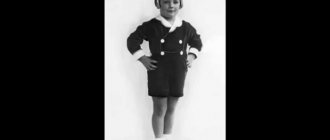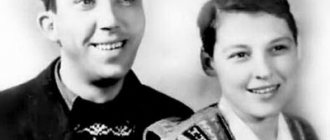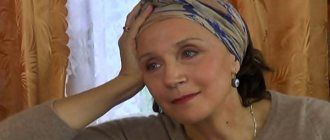Wikipedia has articles about other people with the last name Schneider.
| Romy Schneider | |
| Romy Schneider | |
| Schneider in 1973. | |
| Birth name | Rosemary Magdalena Albach |
| Date of Birth | September 23, 1938(1938-09-23) |
| Place of Birth | Vienna, Austria |
| Date of death | May 29, 1982(1982-05-29) (age 43) |
| A place of death | Paris, France |
| Citizenship | Germany France |
| Profession | actress |
| Career | 1953—1982 |
| Awards | "Cesar" (1975, 1978) |
| IMDb | ID 0002769 |
| romy.de | |
| Media files on Wikimedia Commons | |
Romy Schneider
(German: Romy Schneider; née
Rosemarie Magdalena Albach
(German: Rosemarie Magdalena Albach); September 23, 1938, Vienna - May 29, 1982, Paris) - German-French film actress, star of Austrian, German and French cinema. Along with Marlene Dietrich and Hildegard Knef, Romy Schneider is one of the most famous German actresses of the 20th century who gained international success and fame.
Romy Schneider made her film debut at the age of 15. Together with her mother Magda Schneider, she played in the melodramatic films “When the White Lilac Blooms” (1953) and “March for the Emperor” (1955). In 1955-1957, Romy starred in the role of the Austrian Empress Elisabeth in Ernst Marischka's film trilogy "Sissi" and achieved international recognition, but found herself hostage to this leafy film image.
In search of more complex roles, Schneider went to Paris in 1958, where she made her theatrical debut in John Ford's tragedy "It's a Pity She's a Whore." In 1963, Romy Schneider starred in the United States in the film The Cardinal, for which she received a Golden Globe nomination. In 1969, Schneider starred with Alain Delon in the film “The Swimming Pool.”
In the 1970s, Romy Schneider was at the peak of her acting career. She starred in character roles for famous film directors Claude Sautet, Andrzej Zulawski and Luchino Visconti and became one of the most successful actresses in French cinema of that time. For her roles in the films “The Main Thing Is to Love” (1975) and “A Simple Story” (1978), Romy Schneider received the Cesar Award for Best Actress.
The last film with the participation of Romy Schneider, “Passer from Sans Souci,” was released in 1982, a few weeks before the actress’s death. In 2008, Romy Schneider was awarded the Cesar Award for outstanding achievements in cinema posthumously. The French Romy Schneider Award, awarded to young film actors, and the Austrian television Romy Award are named after Romy Schneider.
Biography[ | ]
Childhood[ | ]
Goldenstein Castle near Salzburg
Romy Schneider was born into an acting family. Romy Schneider's mother is German film star Magda Schneider, her father is the hereditary Austrian actor Wolf Albach-Retti. Romy Schneider's paternal grandmother is actress Rosa Albach-Retti, and Romy's great-grandfather Adolphe Retti was an actor and director.
Romy, along with her younger brother Wolf-Dieter, was raised by her Schneider grandparents in the village house Mariengrund in Schönau am Königssee, Bavaria. The actor-parents rarely saw their children; they subsequently separated in 1943, and finally divorced in 1945. Romy's father remarried in 1947 to the Austrian actress Trude Marlene, and Magda Schneider married Cologne restaurateur Hans Herbert Blazheim in 1953. In September 1944, Rosemary Magdalena Albach went to primary school in Schönau, where she studied for four years. The girl was not good at mathematics, she loved to sing, she was attracted to local history, history and drawing. From July 1949, she was brought up in a boarding school for girls at Goldenstein Castle, a private school at the Augustinian monastery in Elsbeten near Salzburg. As the nun Sister Augustine stated in an interview with Paris Match magazine on August 6, 1982, Romy’s mother rarely appeared to see her daughter, and Rosa’s father and grandmother never visited Goldenstein. Romy herself recalled that at the boarding school she was a big dreamer and could, for example, talk about Gary Cooper, with whom she supposedly had lunch just yesterday. Romi’s mother recalled that the head of the boarding school complained about Romi: she often played mischievous pranks at the boarding school, was not very friendly, and skipped classes. However, Romi was passionate about drawing, was fond of theater, often performed in school plays, was a soloist in a church choir, and dreamed of becoming an actress and acting in films. In her diary, 13-year-old Romy wrote: “Music, theater, cinema, travel, art. These five words make my theatrical blood boil.” Having completed her studies at the boarding school, Romy was going to enter an art school in Cologne after the summer holidays to develop her abilities in painting and drawing, but she had to abandon these plans for her first film role.
Start of career in the 1950s[ | ]
In the entertaining film “When the White Lilac Blooms,” Romy’s mother Magda Schneider received the leading female role and invited producer Kurt Ulrich and director Hans Deppe to try their daughter Romy for the role of the daughter of their heroine Efchen Forster, although, by her own admission, she had no idea about her daughter’s desire to become an actress, nor about her abilities. 14-year-old Romy Schneider successfully passed the audition at the UFA
in Berlin in early September 1953 and was approved for the role. Filming with the participation of the famous Willy Fritsch, who noted the amazing acting abilities of the debutante, took place in Wiesbaden and ended on November 9, 1953. The premiere took place two days later at the Universum cinema in Stuttgart. By this time, Magda Schneider already had a close relationship with the Cologne restaurateur and entrepreneur Hans Herbert Blazheim, whom she married in December 1953.
In May 1954, Schneider began filming her second film, Fireworks, starring Lilli Palmer, where she played the young girl Anna Oberholzer, who left her home to work in the circus tent. It was in the credits of this film that the actress was first listed under her famous pseudonym. During filming, Schneider met Ernst Marishka. The director had already cast another actress, Sonya Tsiman, for the main role in his new film about the young Queen Victoria of Great Britain, but after meeting Romy Schneider, Mariska unexpectedly gave the role to her. The brilliantly performed leading role in the film “The Young Years of the Queen,” which was a huge success, made the charming Romy a favorite of the public, forcing her mother Magda Schneider into the shadow of supporting roles in her daughter’s films.
In 1955, Schneider again worked with Ernst Marischka and for the third time starred with her mother in the film “March for the Emperor,” a remake of the film “Spring Parade” (1934), and the main male role in this film was played by Romy’s father. The film received excellent criticism, and Romi performed the song “Birds Sing Songs” ( Wenn die Vöglein musizieren)
) was soon released on record. In the shortest possible time, Romy Schneider became one of the most successful stars of German-language cinema and contributed to a new round in her mother’s film career in post-war Germany. In 1955, New Film magazine presented Romy with her first film award as the most popular young film star. That same year, Schneider starred in The Last Man, a remake of the 1924 film of the same name, where she co-starred with Joachim Fuchsberger and Hans Albers. But this black and white film did not receive as much praise as Romy Schneider's first films.
The blessing and curse of the Sissy film trilogy[ | ]
Filming for Sissy began in August 1955. The director chose 16-year-old Romy for the main role in his historical film about the youth of Empress Elizabeth. The film also stars Romy's mother as Duchess Louis and Elizabeth's mother. The main male role of the Emperor of Austria-Hungary Franz Joseph I went to Karlheinz Böhm. Romy and Karlheinz interacted well on set, but their relationship remained purely professional. Expensive filming continued until the end of the year.
The world premiere of Sissi took place on December 21, 1955 at the Apollo Theater in Vienna, and the film was released in West Germany the next day. Thanks to her role in this film, Romy Schneider gained worldwide fame, and her popularity in her homeland also increased. According to the results of the survey, Romy Schneider was ranked second among the most popular actresses in Germany in November 1955, second only to Maria Schell. In March 1956, Romy Schneider appeared on the cover of Der Spiegel
. In Germany, each of the three Sissi films was watched by about six million people over the next two years.
Her stepfather Hans Herbert Blazheim became Romy Schneider's manager. He managed her income and controlled the roles she was offered. Despite the huge success of the first film, Schneider refused to star in its sequel, but Blatzheim and the filmmakers of Sissi the Young Empress eventually convinced her. The 1957 film Robinson Must Not Die, starring Romy Schneider and Horst Buchholz, failed to replicate the success of the second Sissi film. Romy Schneider's second role as the Austrian Empress earned her a nomination for the 1957 Bambi Award.
In 1957, Romy Schneider played the role of the narrator in the musical fairy tale “Peter and the Wolf,” which was released on record by Herbert von Karajan, and starred in three films: “Montpti” (1957), for which Romy Schneider flew to Paris for the first time, “Scampolo” "(1958) directed by Alfred Weidenmann and in the third and final film of the Sissi trilogy - Sissi. The Difficult Years of the Empress" (1957).
Schneider was afraid of becoming an actress of one role and refused to star in the fourth film about Sissy. Among the consequences of this decision by Romy Schneider were not only financial losses, since Romy's fee was a million German marks. By 1959, Magda Schneider began acting much less frequently, and her relationship with her stepfather deteriorated. Blatzheim preferred financially profitable roles and relied on spectacular advertising appearances and did not take into account the creative needs of his stepdaughter. Romi was tired of being looked after and began to protest.
Break[ | ]
Poster for the film “Angel on Earth”
In early 1958, Romy and Magda Schneider went on a three-week trip to the United States and visited New York and Hollywood. The occasion was the New York premiere of the film with her participation, “The Young Years of the Queen,” which was released in American distribution under the title “Vicky’s Story.” Schneider gave several interviews on radio and television, visited major film studios in Hollywood, was introduced to Walt Disney and talked with colleagues Helmut Keutner, Curd Jurgens and Sophia Loren.
Returning to Germany, Schneider starred in the film Girls in Uniform, where her partners on the set were Lilli Palmer, Teresa Giese and Christina Kaufman. The film, directed by Gesa von Radvanyi, takes place in Prussia in 1910. Boarding school student Manuela von Meinhardis, played by Romy Schneider, falls in love with her teacher, played by Palmer. The self-critical Schneider took her role seriously and earned praise from the press.
In June 1958, filming began on Christine, a remake of the 1933 film based on Arthur Schnitzler's play The Game of Love, in which Romy played the same role as her mother in 1933. Romy Schneider's fee for this film was 500 thousand German marks, thereby becoming the highest paid actress in Germany in 1958. Romy's partner in the film "Christine" was the little-known actor Alain Delon at that time. The couple had a romantic relationship not only on screen, but also in life. At the end of filming in the fall of 1958, 20-year-old Schneider went with Delon to Paris. Romy's family did not accept Delon, unable to prohibit this relationship, Schneider's parents insisted on their official registration, and on March 22, 1959, Delon and Schneider's engagement took place on Lake Lugansk.
Actress Romy Schneider went to Paris not only for love. For her, Paris meant a final break with her parents' home and hope for a new turn in her career. Romy turned her back on the German film industry, and the press in her homeland was offended by her for a long time. While living in Paris, Schneider fulfilled her contractual obligations and starred in the 1959 films Angel on Earth, The Beautiful Liar and Katya, the Uncrowned Queen, and played the title role in Fritz Kortner's television film The Comedy of Lysistrata in 1961 year. Schneider then began to settle into her new life in France.
Life in Paris in the first months was not always easy for the actress. Schneider, accustomed to success, did not receive offers of new roles, and Alain Delon at that time quickly became famous and acted a lot. The situation changed for the better when Delon introduced Schneider to director Luchino Visconti, who offered her a role in the theatrical production of “It’s a Pity She’s a Lecher” by John Ford. To play with Delon in the Renaissance drama on the stage of the Paris Theater, Romy Schneider took French lessons from her colleague Raymond Jerome and studied French phonetics with a teacher. Schneider, who had no conventional acting training, later named Visconti among her teachers. The premiere of the play, attended by Ingrid Bergman, Shirley MacLaine and Jean Cocteau, took place on March 29, 1961 and brought Schneider her first success in France, followed by offers of new roles.
In the same year, Schneider starred in Visconti's film Boccaccio 70 and went on a long tour with A.P. Chekhov's The Seagull, directed by Sasha Pitoeff. Schneider later played the role of Leni in Orson Welles' film The Trial with Anthony Perkins. Schneider herself considered the film adaptation of Kafka's work one of her most important films, for her role in it she was awarded the French Crystal Star film award as the best foreign actress. In The Winners (1963), directed by Karl Forman, Schneider played a young violinist forced into prostitution during World War II. To convincingly play the role, Schneider even took lessons from David McCallum. In Otto Preminger's film The Cardinal (1963), Schneider played the role of Baroness Annemarie von Hartmann and arranged for her father to play a cameo role as Baron von Hartmann. For this role, Schneider was nominated for a Golden Globe as Best Leading Actress in a Drama.
In the fall of 1963, Schneider flew to Los Angeles to film her first Hollywood film, Good Neighbor Sam, starring Jack Lemmon. Her career was going great, but her personal life suffered a setback: from the newspapers, Romy learned about Delon’s affair with Natalie Barthelemy. When Schneider returned home to Paris from the USA, Delon had already moved out of their shared apartment and soon married Barthelemy. Schneider attempted suicide and refused to work for a long time. The highly successful film Good Neighbor Sam premiered on July 22, 1964. At this time, Schneider returned to work and starred in Henri-Georges Clouzot's film "", but the project did not work out right away. Actor Serge Reggiani, Romy's partner in the film, became seriously ill, which confused all plans, and three weeks after the start of filming, the director had a heart attack. The film remained unfinished. The following year, Schneider starred in Paris in the Woody Allen-scripted comedy What's New, Pussy? (1965) starring Peter Sellers and Peter O'Toole.
Return to Germany[ | ]
Romy Schneider.
1971 In April 1965, Schneider flew to Germany to open her stepfather's second restaurant, where she met director and actor Harry Mayen. A romantic relationship arose between them, the couple settled in the Berlin district of Grunewald on Winklerstrasse. Schneider wanted to act in the theater and negotiated with Boleslav Barlog and Fritz Kortner to find suitable material, but these plans were not realized.
Schneider's next film work was the German-French co-production drama The Thief (1966), filmed mainly in Oberhausen. Schneider played with Michel Piccoli for the first time. During the final stages of filming Triple Cross, Schneider and Mayen got married (on July 15, 1966, shortly after his divorce from actress Anneliese Römer). On December 3 of the same year, Romy Schneider gave birth to a son, David Christopher Haubenstock, and devoted the next two years to the family. In February 1967, her father Wolf Albach-Retti died of a heart attack. A year later, the actress’s stepfather also died of a heart attack.
The first film Romy Schneider returned to cinema after the birth of her son was Otley, filmed in the spring of 1968 in London. In the summer of the same year, Schneider again starred with Alain Delon in the film “The Swimming Pool”. The yellow press anticipated a sensational renewal of relations between Schneider and Delon, but the expectations were in vain. The film premiered on January 31, 1969 in Paris and was very successful. After the film “My Lover, My Son” (1970), Schneider starred in “Little Things in Life” (1970) with Claude Sautet. On the set of this film, she again met Michel Piccoli.
1970s Grande Dame[ | ]
Romy Schneider in the film "Max and the Tinmen."
1971 In the 1970s, Romy acted mainly in France, where she received the title of Grand Dame of French cinema. At the beginning of the decade, several films appeared with Schneider in leading roles. After the film "Who?" (1970) in 1971, Bloomfield, Khalifsha and Max and the Tinmen were released. Schneider starred with Alain Delon for the third time in the historical film “The Assassination of Trotsky.”
A year later, Schneider returned to the role of Empress Elizabeth, which was fateful for her in the 1950s, starring in Luchino Visconti’s film “Ludwig” and carefully prepared for the role so that her heroine looked authentic. Filming began in January 1972 in Bad Ischl, with Helmut Berger playing the role of Ludwig. The film was shot in English, and the German dubbing was directed by Schneider's husband Harry Mayen. In 1972, the film “Cesar and Rosalie” was also released, where Schneider played with Yves Montand.
In 1973, Schneider and Mayen, who were living in Hamburg at the time, decided to separate; Schneider and her son went to Paris. She was at the peak of her career and could freely choose her roles, working with outstanding directors and actors - Richard Burton, Jean-Louis Trintignant, Klaus Kinski and Jane Birkin.
In ten months in 1973-1974, Romy Schneider starred in five films. In The Train (1973), Schneider played Anna Kupfer, a Jewish refugee. The sumptuously melancholic Love in the Rain (1974) was followed by The Mad Ram (1974), in which she portrayed an abandoned wife who decides to have an affair in the strange comedy Trio from Hell (1974), opposite Michelle Piccoli and Masha Gonska, Romy Schneider shone as an unscrupulous accomplice to murder. In November 1974, Schneider starred in The Innocents with Dirty Hands (1975), and in April 1975 she began filming The Old Gun (1975), about the Oradour tragedy in 1944. In it, Schneider played the role of the French woman Clara, raped and killed by German soldiers. For her role in the film "The Main Thing Is to Love" (1975), Schneider received her first Cesar for Best Leading Actor in April 1976 and in her acceptance speech thanked her master and friend Luchino Visconti, who had died a few weeks earlier.
The marriage to Harry Mayen was dissolved on July 8, 1975. By this time, Schneider was already in a close relationship with her personal secretary, Daniel Biasini. In September, Schneider found out about her second pregnancy. On December 18, 1975, the wedding of Schneider and Byazini, who was 11 years younger than the bride, took place. Shortly after the wedding, pregnant Romy Schneider was in a car accident and lost her child. Schneider plunged back into work. The actress collaborated with Sautet in the film “Mado” (1976), and played the role of Leni Gruyten in the film adaptation of Heinrich Böll’s novel “Group Portrait with a Lady.” During filming, she learned about a new pregnancy, and on July 21, 1977, Romy Schneider's daughter Sarah Magdalena Biasini was born. In the same year, for her role in the film “Group Portrait with a Lady,” Schneider received a Golden Film Award in the category “Best Performance by a Role.” After the birth of her second child, Schneider worked with Claude Sautet for the fifth and final time. For her role in A Simple Story (1978), Schneider was awarded the Cesar Award for Best Actress on February 3, 1979.
In the late 1970s, Rainer Werner Fassbinder offered Schneider the lead role in the film The Marriage of Maria Braun (1979), but the collaboration did not work out due to Schneider's excessive demands for her fee and her indecisive behavior. In November 1978, Schneider began filming the film adaptation of Sidney Sheldon's novel Blood Bond (1979). Despite the star cast - Audrey Hepburn, Omar Sharif, Ben Gazzara, James Mason and Gert Froebe - the detective film did not arouse enthusiasm among film critics.
Ex-husband Harry Mayen hanged himself in Hamburg on April 14, 1979, Schneider blamed herself for not paying enough attention to him. At the end of the summer of 1979, the film “The Light of a Woman” was released, for which Schneider was again nominated for a Cesar Award. In the film Live Report, released a year later, Schneider played a terminally ill woman who sold the rights to broadcast her death to a television company.
Last years of life[ | ]
In the spring of 1980, Schneider starred in the film “The Banker's Wife,” based on the biography of French fraudster Martha Ano. The start of filming of her next film, “The Phantom of Love” (1981), according to Byasini, was delayed for several days due to the actress’s poor condition as a result of alcohol and medication abuse. In an interview with Stern
"On April 23, 1981, Schneider admitted that her strength was running out. Insurmountable contradictions also emerged in her relationship with her husband Daniel Biasini, and in May 1981, Schneider filed for divorce. That same month, the actress underwent major surgery to remove her right kidney, on which a benign tumor was discovered. But the worst blow of fate awaited Romy Schneider in the summer of 1981. On July 5, her 14-year-old son died as a result of an accident. He tried to climb over the fence on the property near Byazini’s parents’ house, lost his balance and, when falling, ran into a sharp metal fence.
Under Preliminary Investigation, Schneider's penultimate film, was released in France on September 23, 1981, her 43rd birthday. Although after the death of her son it seemed that Romy would not survive this loss, soon in October 1981 she appeared in Berlin on the set of her last film, Passer-by from Sanssouci. In the film, she played the role of Elsa Wiener, who took under her wing a Jewish boy, Max Baumstein, played by 13-year-old Wendelin Werner. After filming, Schneider and her new lover, French producer Laurent Pétain, began choosing a country house for themselves to arrange their life there. In March 1982, they found a house in Boissy-san-Avoire, 50 km from Paris. In April 1982, the premiere of the film “Passer from Sans Souci” took place. Schneider's work was highly praised and was nominated for a Cesar Award. On May 9, 1982, Schneider and Pétain flew to Zurich to see her property manager to solve problems with financing the purchase of a country house. Despite her high earnings, by the end of her life, Schneider found herself in debt: her stepfather Hans Herbert Blatzheim, who handled his adopted daughter’s fees until his death in May 1968, abused her trust and squandered her entire fortune. Daniel Biasini led a luxurious life at the expense of the actress, and the French financial authorities demanded payment of taxes amounting to millions. In Zurich, on May 10, 1982, Romy Schneider signed her will, naming her daughter Sarah and Pétain as her heirs.
Grave of Romy Schneider and her son David
Death[ | ]
Almost three weeks later, on the evening of May 28, 1982, Schneider and her lover were invited to dinner with his brother in Paris. On the way home to their shared apartment, they discussed plans for the weekend. At home, Schneider did not want to go to bed right away and decided to listen to music. In the early morning of May 29, 1982, Pétain found the actress, without signs of life, bent over her desk.
In their interviews, Schneider’s personal photographer and her manager ruled out the possibility of the actress’s suicide and justified this by the fact that she was working on a new film project with Alain Delon and was planning to move out of town. The press announced Romy Schneider's death as a result of suicide, but the cause of death was listed as heart failure on the death certificate. It is known that, contrary to doctors’ orders, the actress abused alcohol, sleeping pills and doping after the operation. According to prosecutor Laurent Daven, as a tribute to the movie star and her loved ones, no autopsy was performed on the body, since the circumstances of the death excluded the involvement of third parties.
Romy Schneider was buried in the Boissy-sans-Avoir cemetery. At the insistence of Alain Delon, who was organizing her funeral, the remains of her son were reburied in her mother’s grave.
Memory[ | ]
In the 18th arrondissement of Paris, a small street is named after Romy Schneider.
Paris. Romy Schneider Street
In her native Vienna, in the 23rd district, a small street is also named after her.
Vein. Romy Schneider Street
In a number of other cities in France, Germany and the Netherlands, streets are named after her (https://romyschneider.heimat.eu/flohmarkt.htm).
The feature film “Romy” (2009) is dedicated to her.
Romy Schneider
Actress Romy Schneider – natural beauty
Looking at this beautiful woman, you understand that everything in her life should be wonderful. However, fate decreed something completely different. Her life was so tragic that she died quite unexpectedly, sitting at her desk.
I discovered this actress after the film “Swimming Pool”. A detective film by Jacques Deray, in which they are trying to find the killer of one of the characters, would not have interested me very much if not for the performance of Romy Schneider. Tension, love and hatred are mixed, and an incredibly beautiful woman with such blue eyes is the very personification of love.
She attracted troubles
At that time, she was no longer with Alain Delon. And she survived the terrible tragedy of his betrayal. When, while in a relationship with her, he unexpectedly marries someone else.
She, too, is trying, despite the betrayal, to build a relationship with another person. And she even has a son in this marriage, whom she loves very much. But all this does not bring her a feeling of happiness. A few years later, the son dies tragically, while climbing over a fence with sharp bars, he impaled himself on one of them.
In fact, Romy Schneider, an actress with enormous potential, who has played many interesting roles in both French, Austrian and German cinema, turns out to be completely unlucky in her personal life.
The actress and the accident
She was born into a family of famous film actors - Magda Schneider and Wolf Albach-Retti, so her path to cinema, thanks to her parents, was relatively simple.
When her parents divorced, Romy was only 4 years old, and she was raised by her grandparents, who then sent her to a convent, where she lived until she was 14 years old.
The girl had creative roots and dreamed of becoming an artist, but her mother brought her to the set and asked her to take her to the film where Romy was to play her mother’s daughter.
This is how her journey into cinema began. In the film “Christine” she met Alain Delon and they began a whirlwind romance. It was for him that she moved to France.
Where she met the famous director Luchino Visconti and fashion designer Coco Chanel. These two people honed the skills and style of Romy Schneider. For a long time she was considered the number one actress in France.
But there was no happiness in his personal life, although Romy Schneider and Alain Delon were the most beautiful couple at that time. Alain Delon, after 5 years of relationship, never proposed marriage to Romy Schneider. I always remember my grandmother’s expression that a man should be a little more beautiful than a monkey. There is probably some truth in this.
Filmography[ | ]
- 1953 - When the white lilac blooms / Wenn der weiße Flieder wieder blüht
- 1954 - Fireworks / Feuerwerk
- 1954 - The Queen's Young Years / Mädchenjahre einer Königin
- 1955 - March for the Emperor / Die Deutschmeister
- 1955 - The Last Man / Der letzte Mann
- 1955 - Sissi / Sissi
- 1956 - Kitty and the Wide World / Kitty und die große Welt
- 1956 - Sissi - the young empress / Sissi - Die junge Kaiserin
- 1957 - Sissy. The Difficult Years of the Empress / Sissi – Schicksalsjahre einer Kaiserin
- 1957 - Robinson must not die / Robinson soll nicht sterben
- 1957 - Monpti / Monpti
- 1958 - Scampolo
- 1958 - Christine / Christine
- 1958 - Girls in uniform / Mädchen in Uniform
- 1959 - The Beautiful Liar / La Belle et l'Empereur
- 1959 - Angel on Earth / Ein Engel auf Erden
- 1959 - Half Tender / Die Halbzarte
- 1959 - Katya - the uncrowned queen / Katia
- 1960 - In the bright sun / Plein Soleil
- 1961 - Comedy about Lysistrata / Die Sendung der Lysistrata
- 1961 - Boccaccio '70
- 1962 - Process / Der Prozeß
- 1962 - Battle on the Island / Le Combat dans l'île
- 1963 - The Winners / Die Sieger
- 1963 - The Cardinal / The Cardinal
- 1964 - Good Neighbor Sam
- 1964 - / L'Enfer
(not finished) - 1965 - What's new, pussy? / What's New Pussycat?
- 1966 - The Thief / La voleuse
- 1966 - Triple Cross / Triple Cross
- 1966 - At 22:30 in summer / 10:30 PM Summer
- 1968 - Otley / Otley
- 1969 - Pool / La Piscine
- 1970 - Who? (French) Russian / Qui?
- 1970 - Little things in life / Les Choses de la vie
- 1970 - My Lover, My Son / My Lover My Son
- 1971 - Max and the Tinsmiths / Max Et Les Ferrailleurs
- 1971 - Cesar and Rosalie / César et Rosalie
- 1971 - Khalifsha / La Califfa
- 1971 - Bloomfield / Bloomfield
- 1972 - Ludwig / Ludwig
(TV series) - 1972 - The Assassination Of Trotsky
- 1973 - Train / Le Train
- 1974 - The Mad Ram / Le Mouton Enrage
- 1974 - Love in the rain / Un amour de pluie
- 1974 - Hellish Trio / Le Trio infernal
- 1975 - Innocents with dirty hands / Les Innocents Aux Mains Sales
- 1975 - The old gun / Le Vieux fusil
- 1975 - The main thing is to love / L'Important C'Est D'Aimer
- 1976 - Mado / Mado
- 1976 - The Woman in the Window / Une femme à sa fenêtre
- 1977 - Group portrait with a lady / Portrait de Groupe avec Dame
- 1978 - A simple story / Une histoire simple
- 1979 - Bloodline
- 1979 - Light of a woman / Clair de femme
- 1980 - Live report on death / La Mort en direct
- 1980 - The Banker / La Banquiere
- 1981 - Under preliminary investigation / Garde A Vue
- 1981 - Phantom of Love / Fantasma d'amore
- 1982 - Passante from Sans Souci / La passante du Sans-Souci
Literature[ | ]
- G. V. Krasnova.
Romy Schneider. - Art, 1993. - 191 p. — ISBN 5-210-02071-1. - “I, Romy Schneider. Diary" / Comp. R. Seidel / Trans. with him. L. Krylova. — M.: Zebra E; St. Petersburg: “Composer” • St. Petersburg, 2011. - 296 p.
- “Delon and Romy: impossible love” / Bertrand Tessier / Trans. from fr. T. Ponyatina. - Nizhny Novgorod, DECOM, 2012. - 188 p.
- G. V. Krasnova.
Romy Schneider. A story of life and love. — Green lamp, 2012. — 320 p. — ISBN 978-5-905629-28-0.
The film "The Old Gun" and the war
I was also interested in this actress in the film “The Old Gun”. There she is the personification of love, such good family happiness.
The theme of love and revenge runs throughout the film. And we see how Romy Schneider’s husband in the film, such a good-natured doctor, who was the happiest man on earth, suddenly begins to take revenge. Moreover, revenge is not as simple as killing the brutal German soldiers who first killed his daughter and then his wife with a flamethrower, namely, this is how he protects his love. He cannot come to terms with the loss of what is so dear to him in life.
Romy Schneider in the film "The Old Gun" 1975
The theme of war comes very close to every family, be it in Russia or in France. Everywhere there were deaths of absolutely innocent people. And someone:
- Russian soldiers
- Allies
Or such daredevils as Julien Dandieu, who alone decide to defend their family, their piece of native land, their love, and, ultimately, their homeland. And the Nazis are just protecting their “skin.” And he wins because he defends the memory of those whom he loved more than life itself.
Movie plot idea
The very idea of this film is based on the real events of World War II in 1944 in Normandy. The Nazis captured villagers in France and killed 642 people, among them children, women and men. This was the largest massacre of civilians on French soil by the German SS Reich Panzer Army.
This film was shown in Russia in 1976, then it was restored and now it is shown in a completely different quality on television.
This film is for our modern generation. There are no special effects, and the scenes are sometimes completely different from what they are now. But the film is about something completely different, about the fact that sometimes very good-natured people turn into hunted animals when they begin to defend what is so dear to them.
The picture is very sincere, there are so few films like this nowadays. This is what makes her so attractive. Seventy-five years ago, the Second World War was experienced this way, and it is no worse than today’s parades and gala concerts.
This film is in many ways superior to modern war films, in that it focuses even more on love than on revenge - and this is very correct, because the Second World War ended long ago, the current generation does not know it at all, and there are almost no eyewitnesses left. But those who survived it must learn to rebuild the world, taking love, kindness and justice as a basis.
Romy Schneider managed to play such scenes of peaceful family life and such love in this film that this actress can truly be considered great. She was so devoted to her acting profession that “if she had to swim across the English Channel, she would certainly do it,” as her colleague George Hamilton wrote about her.










